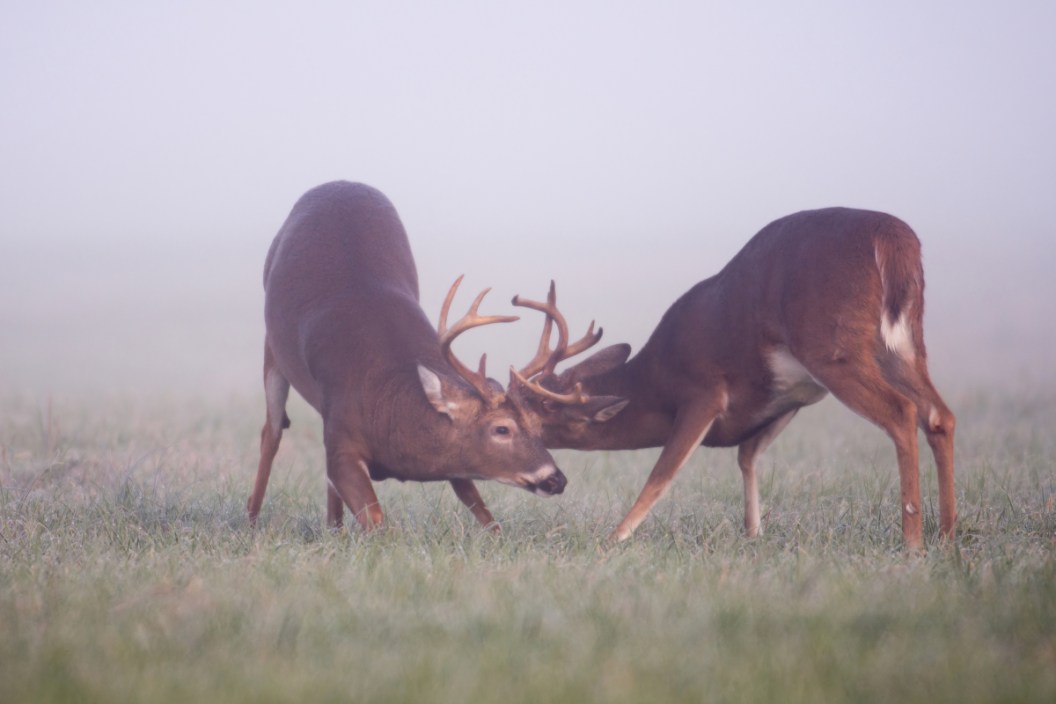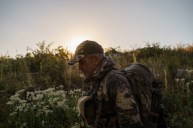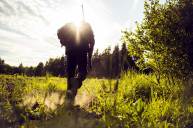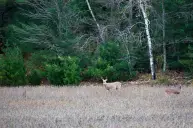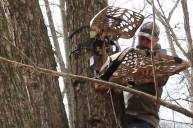Here is how to hunt the rut correctly this year.
It's almost time for that most magical time of year for deer hunting enthusiasts. The start of the rut. It doesn't matter whether you like to hunt whitetail deer, mule deer or blacktails. The rut is the time of year when dominant bucks throw caution to the wind in search of receptive does.
Breeding activity often results in the one and only chance you may have at that big rutting buck this season.
In order to make the most of it this hunting season, let's make sure you're doing it right. These hunting tips will help you to maximize the use of your hunting time.
Keep your impact low with multiple stands.
One of the hardest things for most hunters to do during the peak rut times is to not over hunt. Many deer hunters save all their time off from work all year just for the deer rut. And while it is true that many whitetail bucks let their guard down, you still must think about the impact you're having on your area. Remember, the does are often still on full alert. If the does catch on to what you're doing they'll change habits and the bucks will change with them.
This is where it pays to have multiple stand and blind locations set up months ahead of deer season. Many deer hunters who kill big bucks year in and year out will tell you, "Never hunt the same stand twice in a row." If you do, you're just telegraphing your punches.
Ever notice how you always have more deer sightings the first time you sit in a spot than the second? Like it or not, some animals are going to figure out you're hunting them.
It's important to balance out the hunting pressure you apply to your area. Be unpredictable in where you sit during the peak of the rut. If you have enough tree stands to hunt the entire rut without ever sitting in the same place twice, that's just going to up your odds of success even more.
Be strategic with trail cameras.
This tip feeds off what we just talked about. Trail cameras are a vital asset that can let you know when the mature bucks are starting to let their guard down and cruise during the daylight hours. But here is where hunters are faced with a conundrum. Checking trail cameras leaves an extra human presence in the woods and you don't want to be checking them every single day.
I've heard of some clever hunters who have thought of loopholes around this. There are some hunters who run their tractors back around their food plots and cameras every day at a certain time of day. While whitetail deer know that the tractor means humans, they also don't associate it with humans hunting them most of the time. Run the tractor in front of a camera, quickly swap cards and get out of there. Repeat until you get some daylight photos and you'll know it's time to hunt.
Another option is more time consuming. But it involves keeping detailed records from year to year of when the rut starts in your area. After a few seasons, you'll be able to get away with fewer camera checks because you'll know about when the peak breeding activity is going to start. It's why the pros keep such detailed records of everything that happens on their land, from when the acorns drop and where the bucks are rubbing their antlers to when they see that first signs of chasing. After a while, patterns begin to emerge and it makes rut hunting much easier.
Still another option is to go to all wireless trail cameras that send the photos directly to your mobile device. This is the more expensive route, but it does allow you to keep your impact at zero. Then the only time you enter the woods is when the you know the rut phase has begun.
Consider cutting back on hunting before the rut.
Many bowhunters might consider it blasphemy to think about missing opening morning of archery season. However, there is something to be said for skipping the early season and pre-rut and waiting for when the hot does will be driving the bucks mad.
First off, hunting less in the early season will throw the deer off a bit. Like it or not, they probably already know you take the first couple weeks of archery season off to hunt. Holding off during the early season might get them to think you've moved on and aren't hunting anymore. The second thing it does is it makes your hunting area a sanctuary. As the neighbors are applying hunting pressure all around you, the deer are going to go to where the hunters aren't. Which is your land!
By the time the rut gets here, the deer woods are relaxed and the bucks are too distracted by breeding to even think about you being there. Until it's too late for that big buck. Don't believe me that being patient works? Hunting season here in Michigan starts October 1. But my uncle has focused primarily on starting his hunting in late October or even early November. Either way, he hasn't headed out until the main phase of the rut has started the last several seasons. Last year it produced a wide, beautiful 127-inch 9-pointer and the year before that it was a 133-inch 9-pointer. A few years before that it was a gorgeous 125-inch 8-pointer. Who wouldn't be happy with a few seasons like that?
Stay out all day during the whitetail rut.
We know that this is going to sound like a broken record because every rut article ever has said the same thing, but it needs repeating again. During the rut, it pays to stay in the stand all day if you have the time and the will to do it. Deer movement during the whitetail rut or any rut for that matter often picks up around midday. Many pros swear by hunting all day to bag a good buck year after year.
It also increases the chance you'll run into a wanderer looking for estrous does. This time of year gets deer seeking does far away from where they are typically seen. I've seen at least two instances of this myself. The first happened nearly 20 years ago when my dad shot a gnarly and very old 10-pointer. It was a deer my uncle had never seen before and we found out why roughly a week later. That buck had been hanging out nearly six miles away for most of the season before that. The hunters who had been after him had given the old deer the nickname "Grayface" because of his light charcoal-colored muzzle. That is what this time of the year can do to these bucks. If you can find a quality doe bedding area to stake out, your odds of success are good.
Remember that 133-inch buck I mentioned that my uncle shot a few years ago? We found out later that buck was a wanderer too. Two other hunters had been watching that deer all summer. But he wandered nearly five miles from his home turf that day in search of a doe and instead met up with the business end of a broadhead.
The point I'm making here is that anything can happen during the rut. But if you're not in the woods, it can't happen to you!
Plan around prediction times and moon phases.
There has been lots of research into how the moon affects deer behavior and at this point, most experts agree, it does play a role. This is where a lot of experts get their rut prediction times from. Don't discount them. If they're saying the full moon is going to be the best time to be in the woods, you'd better be there!
Sometimes these predictions will even tell you what kind of behavior to expect. If the prediction says feeding, set up on food sources, if it says chasing, set up outside of bedding areas. Adjust your style of hunting and the spot you sit to coincide with the right dates for the most success.
Some hunters put together a calendar where they plan all their hunts in advance based on moon phases. They have a list of stand options to coincide with which way the wind is blowing. You may have to make some adjustments for weather, but otherwise it helps to listen to these predictions. Many states now have their own wildlife agencies putting out these reports every year free of charge to the public. Check them out. Knowledge is power when it comes to deer hunting.
Make full use of calls and scents.
While hunters often make use of scents and calls all during the season, they will always be most effective during the rut. The one big mistake most people make is that they are too aggressive. This just broadcasts your location to the deer when you're bashing two giant sheds together trying to replicate a fight between two Boone and Crockett bucks. You want to be subtle. Especially with rattling and grunting. Try to make it sound like there's a couple year-old bucks having a little spar. Mature bucks won't like the idea of that. Especially if he's got a doe in estrus nearby.
As soon as you've got the buck's attention, you need to lay off the calling. He'll start searching with his eyes and his nose. It helps if you're in thick cover because he'll have to move closer to search more thoroughly.
The prime time to use a decoy is during the rut. Use it in conjunction with estrus bleats and scents to bring in cruising bucks. Using a buck and doe decoy will bring in dominant bucks looking to steal away a mate. Either way, a decoy puts the deer's focus on that and not you. You may find you're able to get away with more movement in a situation like this than you normally would. Which is a good thing if the buck is approaching you from a weird angle.
Breeding season for deer is the best time of year for a hunter to ambush a buck that would normally outwit all hunters. Give these tips a try this year to truly hunt the rut the right way.
Products featured on Wide Open Spaces are independently selected by our editors. However, when you buy something through our links, we may earn a commission.
For more outdoor content from Travis Smola, be sure to follow him on Twitter and check out his Geocaching and Outdoors with Travis YouTube channels.
NEXT: 3 QUESTIONABLE HUNTING SCENARIOS: WHAT WOULD YOU DO?
WATCH
